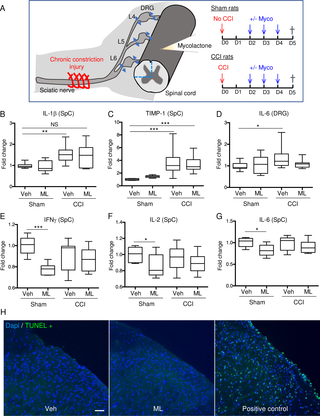PLOS Neglected Tropical Diseases ( IF 3.8 ) Pub Date : 2017-11-17 , DOI: 10.1371/journal.pntd.0006058 Caroline Isaac , Annie Mauborgne , Alfonso Grimaldi , Kemy Ade , Michel Pohl , Cristina Limatola , Yves Boucher , Caroline Demangel , Laure Guenin-Macé

|
Background
Mycolactone is a macrolide produced by the skin pathogen Mycobacterium ulcerans, with cytotoxic, analgesic and immunomodulatory properties. The latter were recently shown to result from mycolactone blocking the Sec61-dependent production of pro-inflammatory mediators by immune cells. Here we investigated whether mycolactone similarly affects the inflammatory responses of the nervous cell subsets involved in pain perception, transmission and maintenance. We also investigated the effects of mycolactone on the neuroinflammation that is associated with chronic pain in vivo.
Methodology/ Principle findings
Sensory neurons, Schwann cells and microglia were isolated from mice for ex vivo assessment of mycolactone cytotoxicity and immunomodulatory activity by measuring the production of proalgesic cytokines and chemokines. In all cell types studied, prolonged (>48h) exposure to mycolactone induced significant cell death at concentrations >10 ng/ml. Within the first 24h treatment, nanomolar concentrations of mycolactone efficiently suppressed the cell production of pro-inflammatory mediators, without affecting their viability. Notably, mycolactone also prevented the pro-inflammatory polarization of cortical microglia. Since these cells critically contribute to neuroinflammation, we next tested if mycolactone impacts this pathogenic process in vivo. We used a rat model of neuropathic pain induced by chronic constriction of the sciatic nerve. Here, mycolactone was injected daily for 3 days in the spinal canal, to ensure its proper delivery to spinal cord. While this treatment failed to prevent injury-induced neuroinflammation, it decreased significantly the local production of inflammatory cytokines without inducing detectable cytotoxicity.
Conclusion/ Significance
The present study provides in vitro and in vivo evidence that mycolactone suppresses the inflammatory responses of sensory neurons, Schwann cells and microglia, without affecting the cell viability. Together with previous studies using peripheral blood leukocytes, our work implies that mycolactone-mediated analgesia may, at least partially, be explained by its anti-inflammatory properties.
中文翻译:

Mycolactone对神经系统具有抗炎作用
背景
分枝内酯是由皮肤病原性溃疡分枝杆菌产生的大环内酯,具有细胞毒性,止痛和免疫调节特性。后者最近被证明是由于mycolactone阻断了免疫细胞对Sec61依赖性促炎性介质产生的影响。在这里,我们调查了Mycolactone是否会类似地影响与疼痛感知,传递和维持有关的神经细胞亚群的炎症反应。我们还研究了甲基内酯对与体内慢性疼痛有关的神经发炎的影响。
方法/原理发现
从小鼠中分离出感觉神经元,雪旺氏细胞和小胶质细胞,用于通过测量镇痛性细胞因子和趋化因子的产生而对肌内酯的细胞毒性和免疫调节活性进行离体评估。在所有研究的细胞类型中,长时间(> 48h)暴露于Mycolactone会在浓度> 10 ng / ml时引起明显的细胞死亡。在最初的24小时治疗中,纳摩尔浓度的Mycolactone可以有效抑制促炎性介质的细胞产生,而不会影响它们的生存能力。值得注意的是,mycolactone还可以防止皮质小胶质细胞的促炎性极化。由于这些细胞对神经发炎起关键作用,因此我们接下来测试了Mycolactone是否会在体内影响这一致病过程。。我们使用了由坐骨神经的慢性收缩引起的神经性疼痛的大鼠模型。在这里,将Mycolactone每天注射入椎管3天,以确保将其正确递送至脊髓。尽管这种治疗未能预防损伤引起的神经炎症,但它显着降低了炎性细胞因子的局部产生,而没有引起可检测的细胞毒性。
结论/意义
本研究提供了体外和体内的证据,表明Mycolactone抑制了感觉神经元,Schwann细胞和小胶质细胞的炎症反应,而没有影响细胞的活力。与以前使用外周血白细胞的研究一起,我们的工作表明,霉固内酯介导的镇痛作用至少可以部分地由其抗炎特性来解释。


























 京公网安备 11010802027423号
京公网安备 11010802027423号